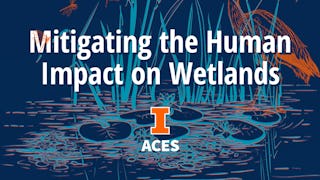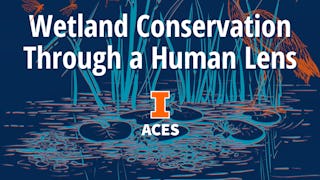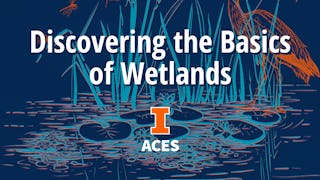This course provides a comprehensive introduction to wetland management, exploring key practices in conservation and restoration. Students will learn the differences between wetland conservation and restoration, and the goals wetland managers typically set for each. The course emphasizes the importance of adaptive management and ecosystem management, contrasting these approaches with traditional wetland management strategies. Students will also gain insight into the constraints that can impact management efforts. In addition, the course covers the components of an effective wetland monitoring plan, the various evaluation techniques used, and the tools employed to track wetland health. Finally, students will explore best practices for wetland restoration, focusing on site-specific techniques and the management of both native and invasive vegetation in restoration projects.


Managing Wetlands: Conservation & Restoration
This course is part of multiple programs.

Instructor: Caitlin Bloomer, Ph.D.
Included with
What you'll learn
Apply ecosystem stewardship concepts and technological tools to wetland restoration and conservation.
Create a wetland restoration plan capable of restoring or replacing ecosystem services and functions.
Skills you'll gain
Details to know

Add to your LinkedIn profile
6 assignments
See how employees at top companies are mastering in-demand skills

Build your subject-matter expertise
- Learn new concepts from industry experts
- Gain a foundational understanding of a subject or tool
- Develop job-relevant skills with hands-on projects
- Earn a shareable career certificate

There are 4 modules in this course
In the course orientation, you will become familiar with the course, your classmates, and our learning environment. The orientation will also help you obtain the technical skills required for the course. Then dive into the second part of this module to understand the reasons for different wetland management practices, describe the differences between wetland conservation and restoration, and identify the types of goals wetland managers may establish. This module will provide a solid foundation for understanding the motivations, goals, and objectives of wetland management and restoration projects.
What's included
14 videos7 readings2 assignments1 discussion prompt
In this module, you will learn how to use publicly available resources to plan for climate change. You will also become familiar with some of the constraints—ecological, socio-political, and economical—that can limit management. Finally, you will apply the concept of adaptive management to wetland restoration planning. This module will equip you with the knowledge and skills to navigate the complexities and uncertainties inherent in wetland management and restoration.
What's included
12 videos4 readings1 assignment
In this module, you will understand methods for monitoring surface and shallow subsurface hydrology. You will also learn how to apply rapid assessment techniques and hydrogeomorphic assessment methods. Finally, you will explore how to establish a monitoring plan for a wetland restoration project. This module will provide you with the essential tools and techniques to effectively monitor and assess wetland restoration efforts.
What's included
15 videos3 readings1 assignment
In this module, you will learn what goes into developing a plan for a wetland restoration project, including basic designs for reestablishing wetland hydrology and soil. This module will bring together all the concepts and techniques you’ve learned, providing a comprehensive approach to planning and executing successful wetland restoration projects. At the conclusion of this module, you will be ready to complete the final assessment for the course and earn your Coursera certificate!
What's included
14 videos6 readings2 assignments
Earn a career certificate
Add this credential to your LinkedIn profile, resume, or CV. Share it on social media and in your performance review.
Instructor

Offered by
Explore more from Environmental Science and Sustainability
 Status: Free Trial
Status: Free TrialUniversity of Illinois Urbana-Champaign
 Status: Free Trial
Status: Free TrialUniversity of Illinois Urbana-Champaign
 Status: Free Trial
Status: Free TrialUniversity of Illinois Urbana-Champaign
 Status: Free Trial
Status: Free TrialUniversity of Illinois Urbana-Champaign
Why people choose Coursera for their career





Open new doors with Coursera Plus
Unlimited access to 10,000+ world-class courses, hands-on projects, and job-ready certificate programs - all included in your subscription
Advance your career with an online degree
Earn a degree from world-class universities - 100% online
Join over 3,400 global companies that choose Coursera for Business
Upskill your employees to excel in the digital economy
Frequently asked questions
Yes! Although completion of the Coursera course alone is not credit-bearing, it is a required component of a graduate-level Canvas course that can be "stacked" toward advanced credentials such as an academic (transcriptable) graduate certificate or a degree. If you decide to pursue further education, the credits you earn from this course can be applied toward a formal academic program, provided that you meet all the requirements of admission to the certificate or degree.
To access the course materials, assignments and to earn a Certificate, you will need to purchase the Certificate experience when you enroll in a course. You can try a Free Trial instead, or apply for Financial Aid. The course may offer 'Full Course, No Certificate' instead. This option lets you see all course materials, submit required assessments, and get a final grade. This also means that you will not be able to purchase a Certificate experience.
When you enroll in the course, you get access to all of the courses in the Specialization, and you earn a certificate when you complete the work. Your electronic Certificate will be added to your Accomplishments page - from there, you can print your Certificate or add it to your LinkedIn profile.
More questions
Financial aid available,

